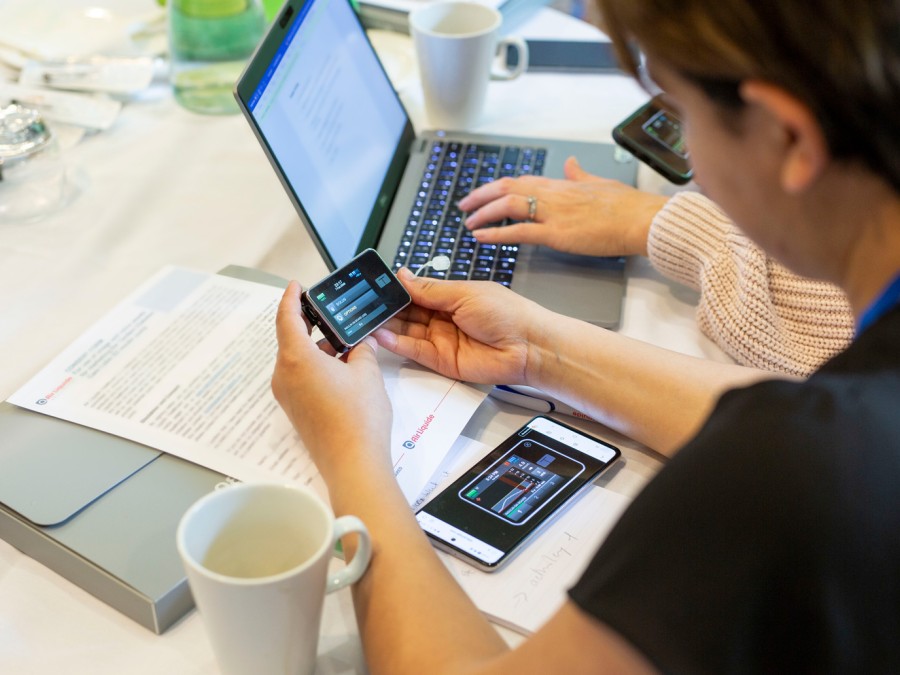Blood Glucose Monitoring: An In-depth Guide

Blood Glucose Monitoring: An In-depth Guide
If you have recently been diagnosed with diabetes, then you may want to know more about blood glucose monitoring — such as what it is, how it works, and the different types of glucose monitoring devices.
Find out more about blood glucose monitoring in our guide below.
What is blood glucose monitoring and why is it important?
When you live with diabetes, regular glucose monitoring is essential to help you manage your blood glucose (sugar) levels, maintain your health and reduce the long-term complications of diabetes.
Blood glucose levels that are too high or low can potentially cause long and short-term complications that may affect your current and future health, and which may even be life-threatening.
Blood glucose monitoring is the process in which you check how much glucose is in your blood to make sure your levels don’t get too high or too low.
Regular glucose testing will help you learn how food, exercise, illness and stress impact your glucose levels, so you can work with healthcare professionals to adjust your treatment, plan your diet and actively manage your diabetes with confidence.
Types of blood glucose testing
Traditionally, blood glucose testing has consisted of two different types of tests: self-monitoring blood glucose levels (SMBG) — which you would do at home, yourself — and blood tests to measure your glycated haemoglobin (HbA1c) which are done by a healthcare clinician.
Below is how both types of blood glucose testing work and what they do.
Self-monitoring of blood glucose levels (SMBG)
Self-monitoring of blood glucose levels involves regular finger-prick testing (several times a day), then using a home-testing kit to measure the blood glucose at that instant in time.
Testing your own blood glucose like this can be done at home or when you’re out and about, without any professional help — your diabetes care team will teach you how to carry out the test and act on the results.
Following a structured self-monitoring regime can help you improve your diabetes management and keep your glucose levels as close to normal as possible when you live with type 1 or type 2 diabetes. However, periodic testing only provides a snapshot of your blood glucose; it can't identify problems between finger-pricks or predict impending episodes of hypoglycaemia.
HbA1c testing
HbA1c testing (or glycated haemoglobin testing) is a blood test that indicates your average blood glucose levels over the previous two to three months.
Your GP or diabetes healthcare team will arrange the test every three to six months to monitor your diabetes management. The target for most people living with type 1 diabetes is 48 mmol/mol (6.5%) or lower — but your healthcare professionals will customise your target according to your diabetes and your needs.
The HbA1c is a very useful test and is the recommended way to assess diabetes management and predict your risk of developing complications.
However, it has some limitations; it only gives an average of your glucose levels and doesn’t detect rapid changes, such as episodes of high or low glucose and hyperglycaemia after eating. In addition, the test can be unreliable if you have certain conditions such as anaemia or haemoglobinopathies (genetic blood disorders) or are pregnant, and may also be affected by genetics or ethnicity.
Types of blood glucose monitoring (and devices)
For people living with diabetes, regular glucose testing can be an uncomfortable and unpleasant lifetime commitment. However, new technologies are providing more effective and comfortable ways of monitoring and regulating blood glucose levels twenty-four hours a day.
Blood glucose monitoring — in particular, continuous glucose monitoring (CGM) — provides a convenient, comprehensive assessment of blood glucose levels and improved management.
There are different glucose monitoring devices available to people living with diabetes. Below, we go into these three options for blood glucose monitoring in more detail.

Continuous glucose monitoring (CGM)
Continuous glucose monitoring or CGM is an innovative way of checking your blood glucose around the clock. An implanted device (which uses a tiny sensor inserted under the skin) automatically tests your glucose levels continuously day and night, even when you’re sleeping.
The sensor relays the results via a transmitter to a monitor so that you see real-time glucose levels, identify glucose patterns and spot highs and lows. Many CGM devices can send alarms or alerts if they detect problems such as hypoglycaemia.
The device measures the glucose in your interstitial fluid (the fluid that surrounds the cells in your body) rather than your blood glucose levels. There is a slight delay between glucose changes in this interstitial fluid and your bloodstream, so your CGM glucose reading may differ from a finger-prick result. This means CGM measures may not always be a reliable indicator in rapidly changing blood glucose levels. You will need to finger-prick to calibrate the device and make important decisions about your diabetes management.
However, research shows that CGM is an improvement in traditional self-monitoring. Using a continuous glucose monitoring device can improve your diabetes management — reducing your risk of hypoglycaemia or hyperglycaemia, reducing your Hba1c and protecting against long-term complications.
Flash glucose monitoring
Flash glucose monitoring (FGM) is sometimes known as intermittently scanned continuous glucose monitoring (isCGM).
Similarly to CGM, flash glucose monitors measure your glucose levels without pricking your finger — using a small sensor implanted just under your skin, which scans the glucose levels in the fluid around your cells. This is worn for up to 14 days.
However, unlike a CGM, the flash monitor doesn’t measure and display glucose readings continuously. Instead, you only get readings on demand — specifically when you intermittently scan your sensor.
Flash glucose monitoring devices are generally considered to have good accuracy, and studies show that they can improve diabetes management and quality of life while reducing the risk of diabetes-related complications. They also represent a cheaper and valid alternative for some people with diabetes, where appropriate.
However, flash devices have some disadvantages — they are not generally as accurate as newer CGM devices and cannot connect to an insulin pump. They also don’t typically warn about hypo- or hyperglycaemia, unlike many CGM systems. Nevertheless, monitoring technology is evolving quickly, and alarms are being added to newer flash models.
Closed-loop technology (artificial pancreas)
A hybrid closed-loop is the most advanced system available for insulin delivery for people living with diabetes.
Also known as an artificial pancreas, hybrid closed-loop systems use an algorithm to take glucose measurements from a continuous glucose monitor, calculate the dose of insulin required and administer the insulin through an insulin pump .
The closed-loop system automatically adjusts the background rate of insulin whenever your blood glucose becomes too low or too high. It works continuously — even when you’re sleeping — repeating the loop cycle at regular intervals every 5-12 minutes (depending on the system used).
Scientific studies have demonstrated that hybrid closed-loop systems appear to be well-tolerated — improving glucose management, reducing the risk of hypos, improving quality of life and reducing the burden of managing type 1 diabetes.
However, hybrid closed-loop systems take learning and understanding to get it working well with your body. You will still need to count carbohydrates in your foods and consider extra bolus insulin doses at mealtimes. Exercise, alcohol, high carbohydrate and high-fat meals all remain challenging to manage even with hybrid closed-loop systems, so management strategies need to be tailored to your individual needs. Training and support from healthcare professionals are also needed.
Source
- Danne T, Nimri R, Battelino T, Bergenstal RM, Close KL, DeVries JH, Garg S, Heinemann L, Hirsch I, Amiel SA, Beck R, Bosi E, Buckingham B, Cobelli C, Dassau E, Doyle FJ 3rd, Heller S, Hovorka R, Jia W, Jones T, Kordonouri O, Kovatchev B, Kowalski A, Laffel L, Maahs D, Murphy HR, Nørgaard K, Parkin CG, Renard E, Saboo B, Scharf M, Tamborlane WV, Weinzimer SA, Phillip M. International Consensus on Use of Continuous Glucose Monitoring. Diabetes Care. 2017 Dec;40(12):1631-1640. doi: 10.2337/dc17-1600. PMID: 29162583; PMCID: PMC6467165. Available from: https://care.diabetesjournals.org/content/diacare/40/12/1631.full.pdf
- Mathew TK, Tadi P. Blood Glucose Monitoring. [Updated 2021 Aug 11]. In: StatPearls [Internet]. Treasure Island (FL): StatPearls Published; 2021 Jan-. Available from: https://www.ncbi.nlm.nih.gov/books/NBK555976/
- NICE Guidelines: Having your blood glucose checked: HbA1c in Type 1 diabetes in adults: diagnosis and management [NG17]. Published August 2015: https://www.nice.org.uk/guidance/ng17/ifp/chapter/having-your-blood-glucose-checked-hba1c
- Ajjan R, Slattery D, Wright E. Continuous Glucose Monitoring: A Brief Review for Primary Care Practitioners. Adv Ther. 2019 Mar;36(3):579-596. doi: 10.1007/s12325-019-0870-x. Epub 2019 Jan 18. PMID: 30659511; PMCID: PMC6824352.
- Villena Gonzales W, Mobashsher AT, Abbosh A. The Progress of Glucose Monitoring-A Review of Invasive to Minimally and Non-Invasive Techniques, Devices and Sensors. Sensors (Basel). 2019 Feb 15;19(4):800. doi: 10.3390/s19040800. PMID: 30781431; PMCID: PMC6412701. Available on: https://www.ncbi.nlm.nih.gov/pmc/articles/PMC6412701/
- NICE Guideline: Type 1 diabetes in adults: diagnosis and management. Updated & reviewed November 2021: https://www.nice.org.uk/guidance/GID-NG10265/documents/draft-guideline
- Mancini G, Berioli MG, Santi E, Rogari F, Toni G, Tascini G, Crispoldi R, Ceccarini G, Esposito S. Flash Glucose Monitoring: A Review of the Literature with a Special Focus on Type 1 Diabetes. Nutrients. 2018 Jul 29;10(8):992. doi: 10.3390/nu10080992. PMID: 30060632; PMCID: PMC6115764. Available on: https://www.ncbi.nlm.nih.gov/pmc/articles/PMC6115764/
- Leelarathna, Lalantha & Choudhary, Pratik & Wilmot, Emma & Lumb, Alistair & Street, Tim & Kar, Partha & Ng, Sze. (2020). Hybrid Closed‐loop therapy: Where are we in 2021?. Diabetes, Obesity and Metabolism. 23. 10.1111/dom.14273
- Hartnell, S., Fuchs, J., Boughton, C.K. and Hovorka, R. (2021), Closed-loop technology: a practical guide. Pract Diab, 38: 33-39. https://doi.org/10.1002/pdi.2350
- Can I get a continuous glucose monitor (CGM) on the NHS?, JDRF. Last accessed 22/12/2021: https://jdrf.org.uk/information-support/treatments-technologies/continuous-glucose-monitors/continuous-glucose-monitor-nhs/





